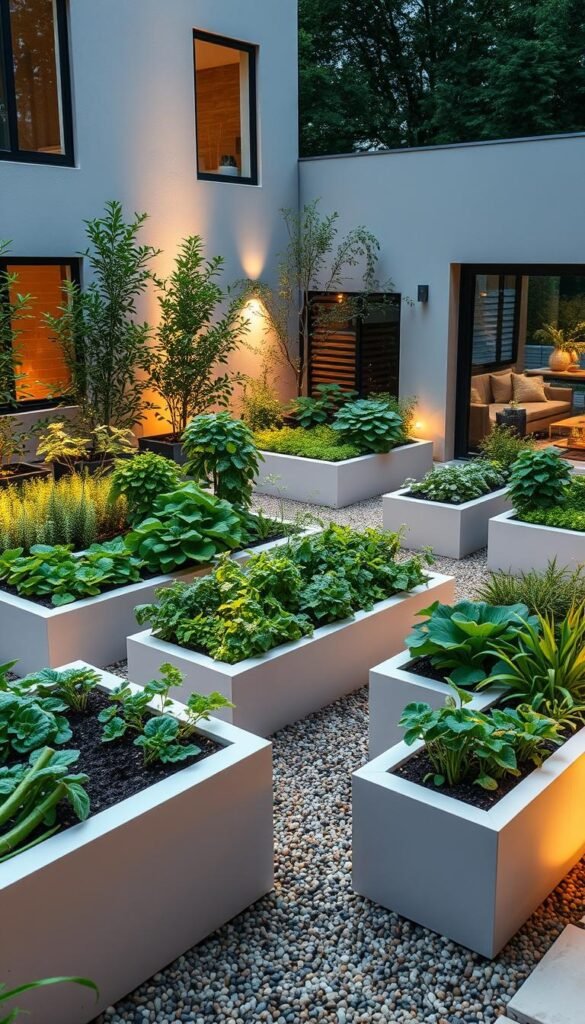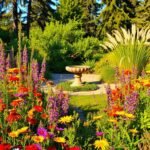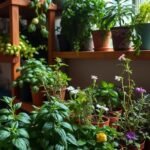Gardening trends have evolved to match today’s lifestyles, prioritizing both beauty and practicality. Instead of sprawling plots, fresh approaches focus on structured layouts that complement your home’s architecture. These spaces balance aesthetics with productivity, proving you don’t need to sacrifice style for fresh herbs or homegrown tomatoes.
Imagine transforming your backyard into a functional art piece. Clean lines and geometric shapes create visual order, while raised beds add depth and simplify maintenance. Neutral-toned materials like corten steel or smooth stone blend seamlessly with urban and suburban settings, turning growing areas into natural extensions of your living space.
What makes these layouts stand out? They’re designed for efficiency. Strategic plant placements maximize yield without clutter, and drought-resistant species reduce water use. Even small yards thrive with vertical planters or compact fruit trees, proving limited space isn’t a barrier.
Beyond looks, these gardens support sustainability. Pollinator-friendly flowers attract bees, while compost systems recycle waste. It’s about creating a harmonious ecosystem that nourishes your household and the environment—all while elevating your property’s appeal.
Modern Vegetable Garden: Sleek Designs That Blend with Contemporary Homes
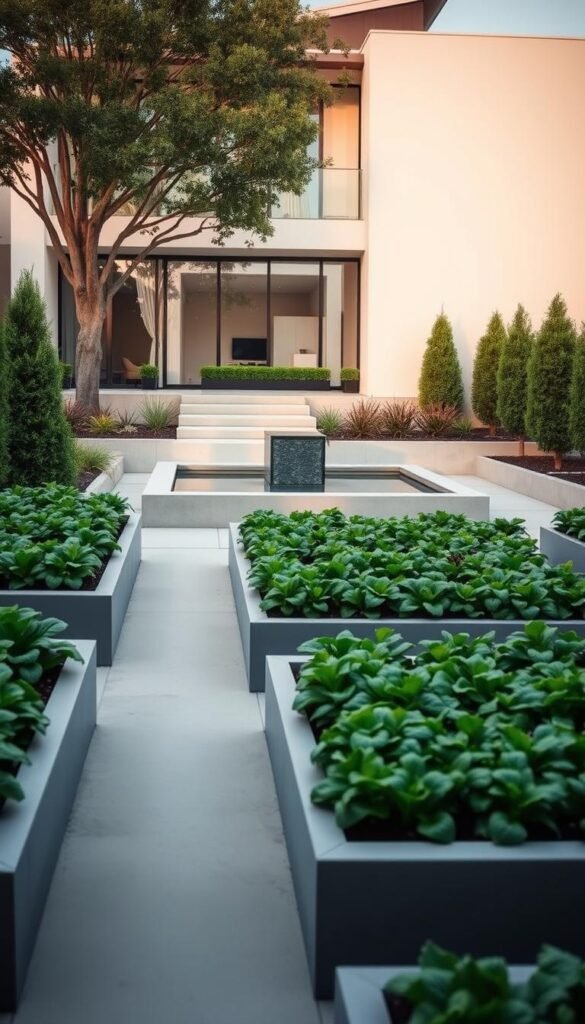
Your outdoor area becomes a bridge between architecture and ecology when planned thoughtfully. By mirroring your home’s angles in planting beds or pathways, you establish rhythm across your property. This approach turns functional growing areas into intentional design features that elevate your entire landscape.
Geometric patterns work wonders for organizing crops while maintaining visual calm. Rectangular raised beds or circular herb spirals add structure without overwhelming the space. Neutral materials like weathered concrete or smooth timber reinforce the connection to your home’s exterior palette.
Strategic plant placement enhances both yield and aesthetics. Taller crops like trellised beans frame views, while low-growing greens create living borders. For smaller areas, vertical planters or dwarf fruit trees offer clever solutions explored in these creative gardening ideas.
Lighting and seating extend usability into evening hours, transforming your plot into an alfresco dining spot. Built-in benches double as herb planters, merging comfort with practicality. These touches make your growing space feel like a purposeful extension of your indoor rooms.
Eco-friendly features blend seamlessly into stylish layouts. Pollinator-attracting blooms border vegetable patches, while discreet compost systems hide near tool sheds. Every element serves multiple purposes, proving sustainability and sophistication coexist effortlessly.
Sleek Garden Design Elements for Contemporary Homes
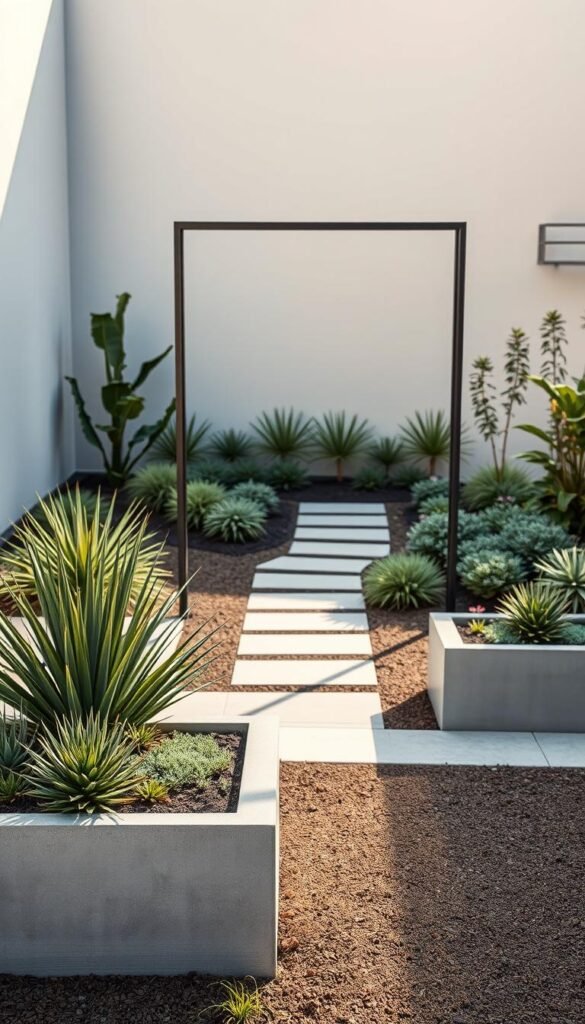
Creating an outdoor space that mirrors your home’s sophistication starts with intentional choices. Focus on elements like crisp edges and restrained color schemes to craft a cohesive look. These principles turn functional areas into deliberate style statements that feel both fresh and timeless.
Embracing Clean Lines and Minimalism
Straight edges define modern spaces, offering visual calm. Try rectangular raised beds or linear pathways that guide the eye. This approach reduces visual noise while maximizing growing potential.
Minimalism doesn’t mean empty. Choose multi-functional features like built-in seating that doubles as herb storage. Every element should earn its place through beauty or utility.
Using Neutral Tones and Natural Materials
Stick to muted palettes—think slate grays and warm taupes—for structural features. These shades let vibrant greens and colorful blooms take center stage. Materials matter too: polished concrete or cedar planters add texture without chaos.
Soft edges work wonders. Low-growing plants like heuchera spill over beds, softening strict lines. Pair them with gravel borders for contrast that’s easy to maintain.
Incorporating Raised Beds with a Modern Twist
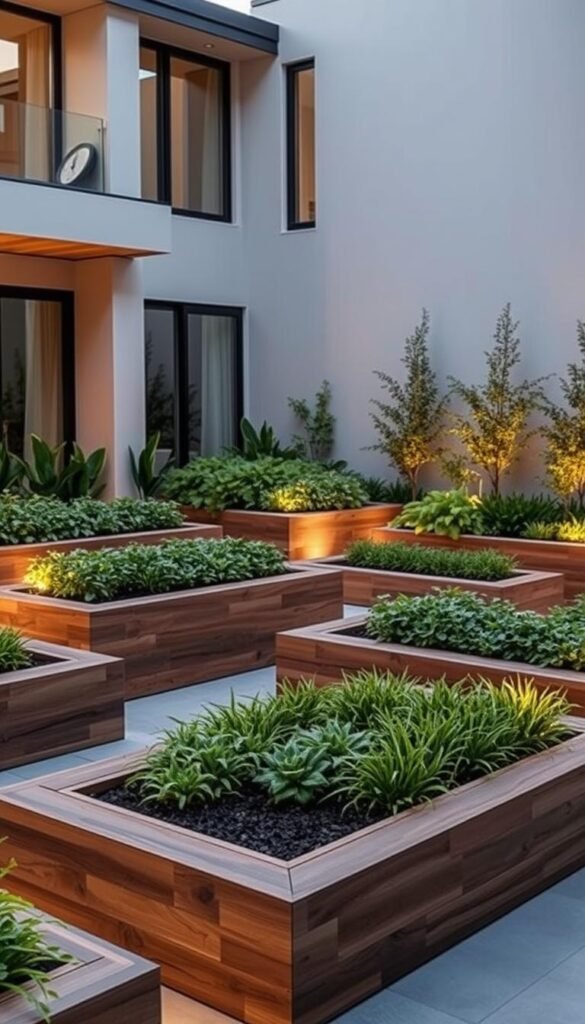
Elevate your outdoor space with raised beds that merge practicality with eye-catching design. These structures do more than grow food—they anchor your landscape with crisp geometry and smart material choices. Whether you’re working with sprawling yards or cozy corners, they adapt effortlessly to your needs.
Selecting Stylish, Durable Materials
Your material selection sets the tone. Powder-coated steel resists rust while adding industrial flair. Composite lumber mimics wood’s warmth without constant maintenance. For earthy textures, try stacked stone or smooth concrete—both age beautifully and complement neutral palettes.
Want a pop of color? Paint metal frames to match your patio furniture or house trim. Natural stone blends with existing pathways, creating seamless transitions between growing zones and lounging areas.
Layout Options to Enhance Functionality
Break free from basic rectangles. L-shaped beds hug corners efficiently, while tiered designs create depth for trailing herbs. Try hexagonal clusters around seating areas—they organize crops and guide foot traffic.
Prioritize sun patterns when positioning beds. Leave 3-foot walkways between them for easy harvesting. Pair tall trellises with low-growing greens to maximize vertical space without crowding.
Incorporate fruit trees in oversized beds for shade-loving lettuces. Edge beds with lavender or marigolds—their blooms attract pollinators while softening sharp angles. Every choice should balance beauty with purpose.
Creative Path and Patio Ideas for a Contemporary Look
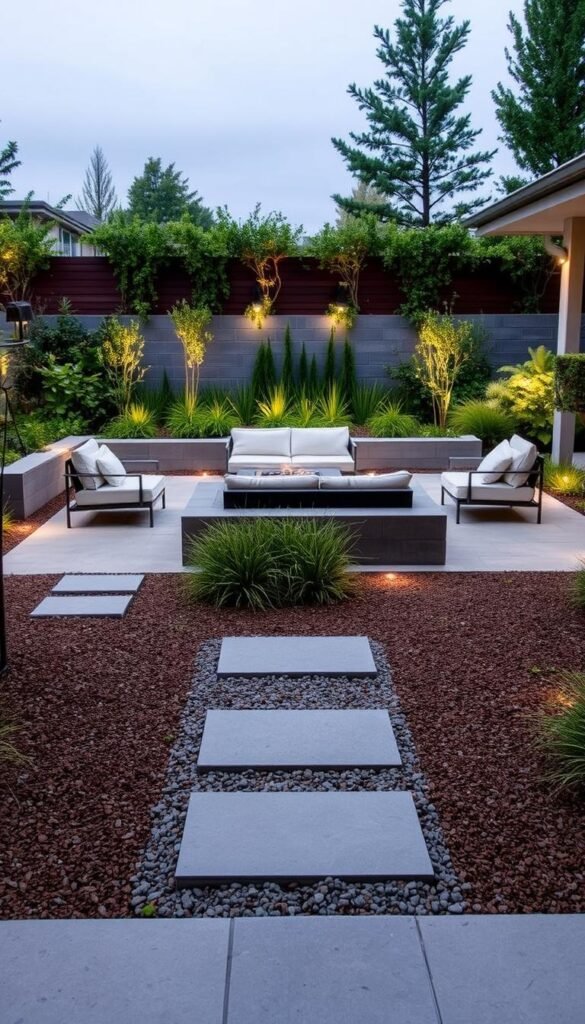
Transform your outdoor space into a functional masterpiece by rethinking how you approach walkways and seating zones. Paths and patios become design anchors when executed with intentionality, merging environmental responsibility with striking visual appeal.
Today’s best layouts prioritize permeability. Instead of solid concrete slabs, consider materials that let rainwater nourish the earth below. This approach reduces runoff while adding texture to your hardscape.
Permeable Paving and Stepping Stones
Gravel pathways offer crisp geometry with natural charm. Pair them with geometric stepping stones for contrast—the irregular gaps between stones become mini planting beds for thyme or moss. This creates a living surface that softens rigid lines.
For patios, try permeable pavers spaced with creeping groundcovers. Sedum or clover fills the joints, managing stormwater while adding pops of green. These solutions maintain clean lines without sacrificing drainage efficiency.
Recycled materials like crushed concrete or salvaged bricks add character to your design. Arrange them in angular patterns that mirror your home’s architecture. Low-maintenance gravel requires no mortar, letting you adjust layouts as your garden evolves.
Incorporate planting pockets directly into paved areas. Herbs like oregano spilling over edges or ornamental grasses rising between stones blur the line between hardscape and garden. This fusion makes every pathway a dynamic part of your landscape.
Integrating Urban Hardscape and Outdoor Living Spaces
Harmonizing durable materials with living elements crafts outdoor rooms that feel both polished and alive. Your landscape becomes a stage for daily life when hardscape features merge effortlessly with planting zones. This balance creates functional spaces where entertainment and relaxation coexist naturally.
Outdoor Kitchens and Built-In Features
Transform your patio into a culinary hub with weather-resistant stone countertops and built-in grills. These kitchen elements blend into your garden design when paired with vertical herb walls or potted citrus trees. Choose materials like bluestone or concrete that echo your home’s exterior for visual continuity.
Smart storage solutions keep tools hidden yet accessible. Drawers under counters store utensils, while overhead racks hold cooking herbs. This approach makes your outdoor kitchen as practical as your indoor one—without sacrificing style.
Café-Style Seating and Relaxation Areas
Create intimate gathering spots with curved benches or modular lounge chairs. Gravel patios bordered by lavender offer texture contrast, while pergolas draped in wisteria provide dappled shade. These spaces invite lingering conversations or quiet morning coffees.
Add warmth with fire pits surrounded by low-maintenance succulents. Built-in planters double as armrests, weaving greenery into seating areas. Every design choice should make your outdoor room feel like a natural extension of your indoor living area.
